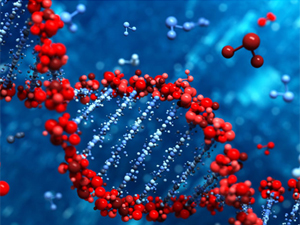



Date:28/04/16
 Researchers at the University of Montreal have created a thermometer that's an astonishing 20,000 times smaller than a single human hair. The work could lead to significant improvements in our understanding of how the human body functions on the nanoscale.
Researchers at the University of Montreal have created a thermometer that's an astonishing 20,000 times smaller than a single human hair. The work could lead to significant improvements in our understanding of how the human body functions on the nanoscale.
We've known for decades that DNA molecules change when they're heated up, and recent discoveries have shown us that molecules such as RNA and proteins are used to report temperature changes in the body. But might it be possible to create nanoscale thermometers to use for our own means?
Well, thanks to a new study, we now know that the answer is yes. According to the researchers, one big benefit of working with DNA is that, in relative terms at least, it's fairly simple. It's made up of four different molecules called nucleotides, the interactions between which are predictable, making them easily programmable.
Based on those known interactions, the team was able to create structures that fold or unfold at specific temperatures. By adding an optical element, they were then able to easily detect signals produced when a certain temperature was hit, all with a thermometer than measures just 5 nm in width.
Aside from being an extremely impressive achievement in their own right, the tiny thermometers may have a big impact on our understanding of molecular biology.
"There are still many unanswered questions in biology," said senior author Professor Vallée-Bélisle. "For example, we know that the temperature inside the human body is maintained at 37° C, but we have no idea whether there is a large temperature variation at the nanoscale inside each individual cell."
The world's tiniest thermometer is made from DNA
 Researchers at the University of Montreal have created a thermometer that's an astonishing 20,000 times smaller than a single human hair. The work could lead to significant improvements in our understanding of how the human body functions on the nanoscale.
Researchers at the University of Montreal have created a thermometer that's an astonishing 20,000 times smaller than a single human hair. The work could lead to significant improvements in our understanding of how the human body functions on the nanoscale.We've known for decades that DNA molecules change when they're heated up, and recent discoveries have shown us that molecules such as RNA and proteins are used to report temperature changes in the body. But might it be possible to create nanoscale thermometers to use for our own means?
Well, thanks to a new study, we now know that the answer is yes. According to the researchers, one big benefit of working with DNA is that, in relative terms at least, it's fairly simple. It's made up of four different molecules called nucleotides, the interactions between which are predictable, making them easily programmable.
Based on those known interactions, the team was able to create structures that fold or unfold at specific temperatures. By adding an optical element, they were then able to easily detect signals produced when a certain temperature was hit, all with a thermometer than measures just 5 nm in width.
Aside from being an extremely impressive achievement in their own right, the tiny thermometers may have a big impact on our understanding of molecular biology.
"There are still many unanswered questions in biology," said senior author Professor Vallée-Bélisle. "For example, we know that the temperature inside the human body is maintained at 37° C, but we have no idea whether there is a large temperature variation at the nanoscale inside each individual cell."
Views: 614
©ictnews.az. All rights reserved.Similar news
- The mobile sector continues its lead
- Facebook counted 600 million active users
- Cell phone testing laboratory is planned to be built in Azerbaijan
- Tablets and riders outfitted quickly with 3G/4G modems
- The number of digital TV channels will double to 24 units
- Tax proposal in China gets massive online feedback
- Malaysia to implement biometric system at all entry points
- Korea to build Green Technology Centre
- Cisco Poised to Help China Keep an Eye on Its Citizens
- 3G speed in Azerbaijan is higher than in UK
- Government of Canada Announces Investment in Green Innovation for Canada
- Electric cars in Azerbaijan
- Dominican Republic Govt Issues Cashless Benefits
- Spain raises €1.65bn from spectrum auction
- Camden Council boosts mobile security





















